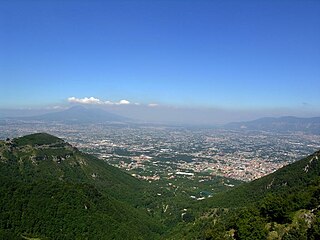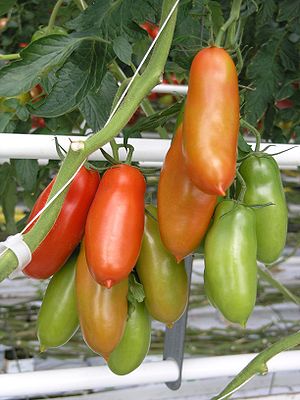
Pizza is a dish of Italian origin consisting of a usually round, flat base of leavened wheat-based dough topped with tomato, cheese, and often various other ingredients, which is then baked at a high temperature, traditionally in a wood-fired oven.
Neapolitan means of or pertaining to Naples, a city in Italy; or to:

An heirloom plant, heirloom variety, heritage fruit, or heirloom vegetable is an old cultivar of a plant used for food that is grown and maintained by gardeners and farmers, particularly in isolated communities of the Western world. These were commonly grown during earlier periods in human history, but are not used in modern large-scale agriculture.

Pizza Margherita or Margherita pizza is a typical Neapolitan pizza, roundish in shape with a raised edge and garnished with hand-crushed peeled tomatoes, mozzarella, fresh basil leaves, and extra virgin olive oil. The dough is made by mixing water, salt and yeast with flour.

A plum tomato, also known as a processing tomato or paste tomato, is a type of tomato bred for sauce and packing purposes. It is generally oval or cylindrical in shape, with significantly fewer locules than standard round tomatoes and a generally higher solid content, making them more suitable for processing into paste. Plum tomatoes are also sometimes favored by cooks for use during the tomato off-season, as they are generally considered more amenable to handling and are therefore available in a state closer to ripe than other supermarket tomatoes.

The Roma tomato or Roma is a plum tomato popularly used both for canning and producing tomato paste because of its slender and firm nature. Commonly found in supermarkets in some countries, Roma tomatoes are also known as Italian tomatoes or Italian plum tomatoes.

The history of pizza begins in antiquity, as various ancient cultures produced flatbreads with several toppings.
San Marzano sul Sarno is a town and comune in the province of Salerno in the Campania region of southern Italy, situated about halfway between Autostrade A3 and A30.

San Valentino Torio is a town and comune in the province of Salerno in the Campania region of south-west Italy. San Valentino Torio is situated in the northern part of the province, not far from Mount Vesuvius, in the Sarno river valley.

Scafati is a comune (municipality) in the province of Salerno, in the Italian region of Campania.

Neapolitan cuisine has ancient historical roots that date back to the Greco-Roman period, which was enriched over the centuries by the influence of the different cultures that controlled Naples and its kingdoms, such as that of Aragon and France.
San Marzano may refer to:

Neapolitan pizza, also known as Naples-style pizza, is a style of pizza made with tomatoes and mozzarella cheese. The tomatoes must be either San Marzano tomatoes or pomodorini del Piennolo del Vesuvio, which grow on the volcanic plains to the south of Mount Vesuvius. The cheese must be mozzarella di bufala campana, a protected designation of origin cheese made with the milk from water buffalo raised in the marshlands of Campania and Lazio in a semi-wild state, or fior di latte, a cow's milk mozzarella created according to the procedure for which it was registered as a traditional speciality guaranteed (TSG). Pizza napoletana is a TSG product in the European Union and the United Kingdom, and the art of its making is included on UNESCO's list of intangible cultural heritage.

Carne pizzaiola or carne alla pizzaiola, sometimes referred to just as pizzaiola, is a dish derived from the Neapolitan and Apulian tradition that features meat cooked with tomatoes, olive oil, garlic, and white wine long enough to tenderize the meat. Most versions also include tomato paste, oregano and basil.

The Agro Nocerino-Sarnese, also inverted as Agro Sarnese-Nocerino, is a geographical region of the Province of Salerno, in Campania in southern Italy; the river Sarno flows through it. It is a low-lying area bounded to the south by the Monti Lattari, to the east and north-east by the Monti Picentini and to the west by the plain of Vesuvius. It consists of sixteen comuni: Angri, Bracigliano, Castel San Giorgio, Corbara, Nocera Inferiore, Nocera Superiore, Pagani, Roccapiemonte, San Marzano sul Sarno, San Valentino Torio, Santa Maria la Carità, Sant'Antonio Abate, Sant'Egidio del Monte Albino, Sarno, Scafati and Siano. All are in the province of Salerno except Santa Maria la Carità and Sant'Antonio Abate, which are in the province of Naples.
Tutta Bella Neapolitan Pizzeria is an Italian restaurant chain with six locations in Washington State. The first location was founded in 2004. The restaurant specializes in "authentic" Neapolitan pizza and is certified by the non-profit Associaziona Verace Pizza Napoletana which certifies pizzerias that use traditional ingredients and processes. Tutta Bella was the first restaurant in the Pacific Northwest to receive such certification.
Acunto Napoli Ovens is an Italian artisanal pizza oven manufacturer based in Naples, Italy. It was founded in 1892 by Vincenzo Acunto and is currently operated by Gianni Acunto.

Pizza marinara, also known as pizza alla marinara, is a style of pizza in Neapolitan cuisine seasoned with only tomato sauce, extra virgin olive oil, oregano and garlic. It is supposedly the oldest tomato-topped pizza.













